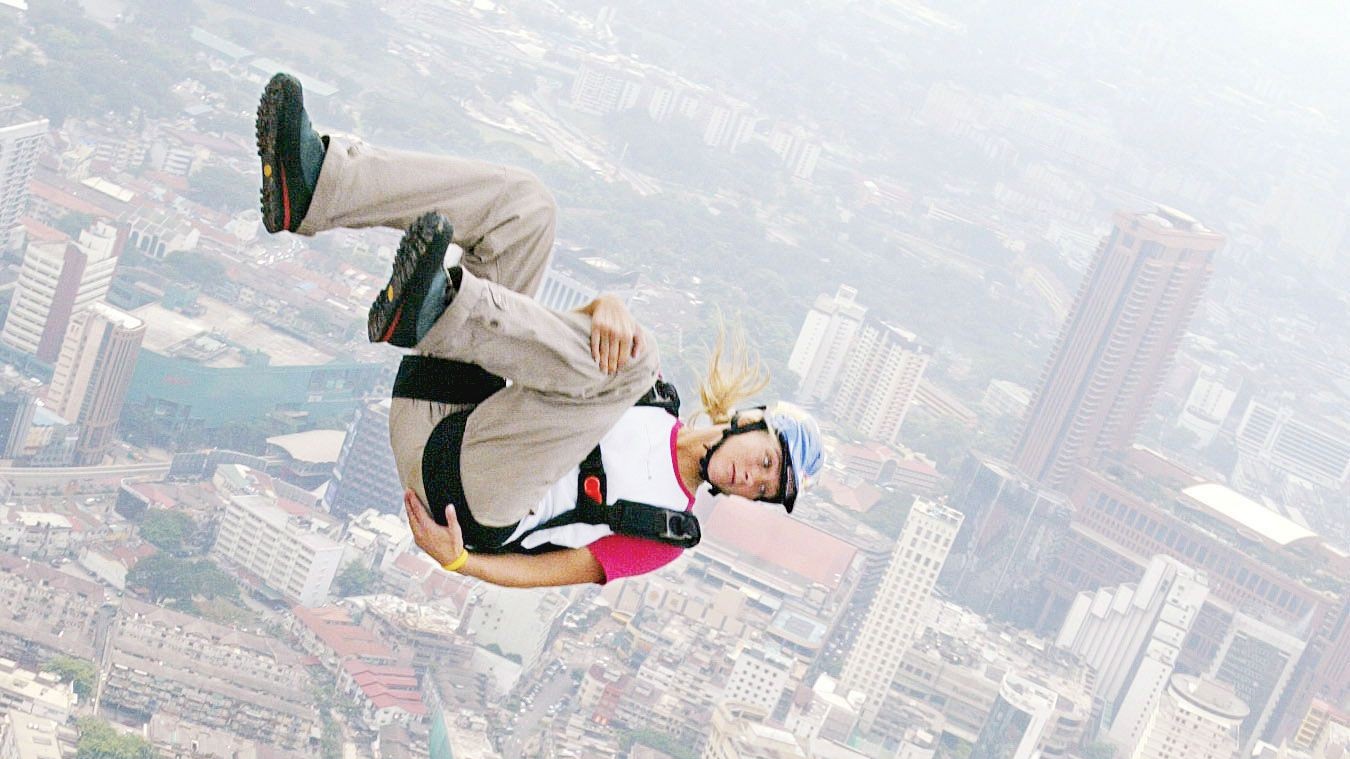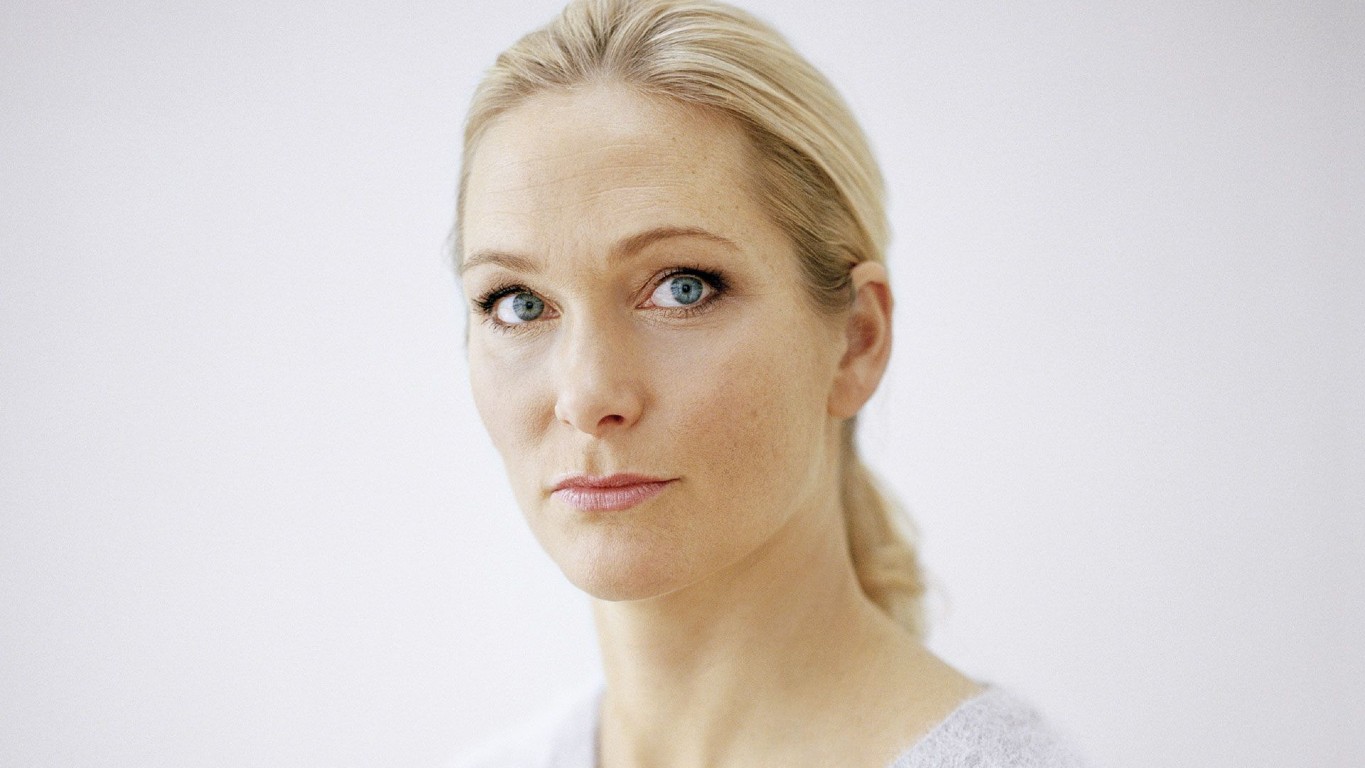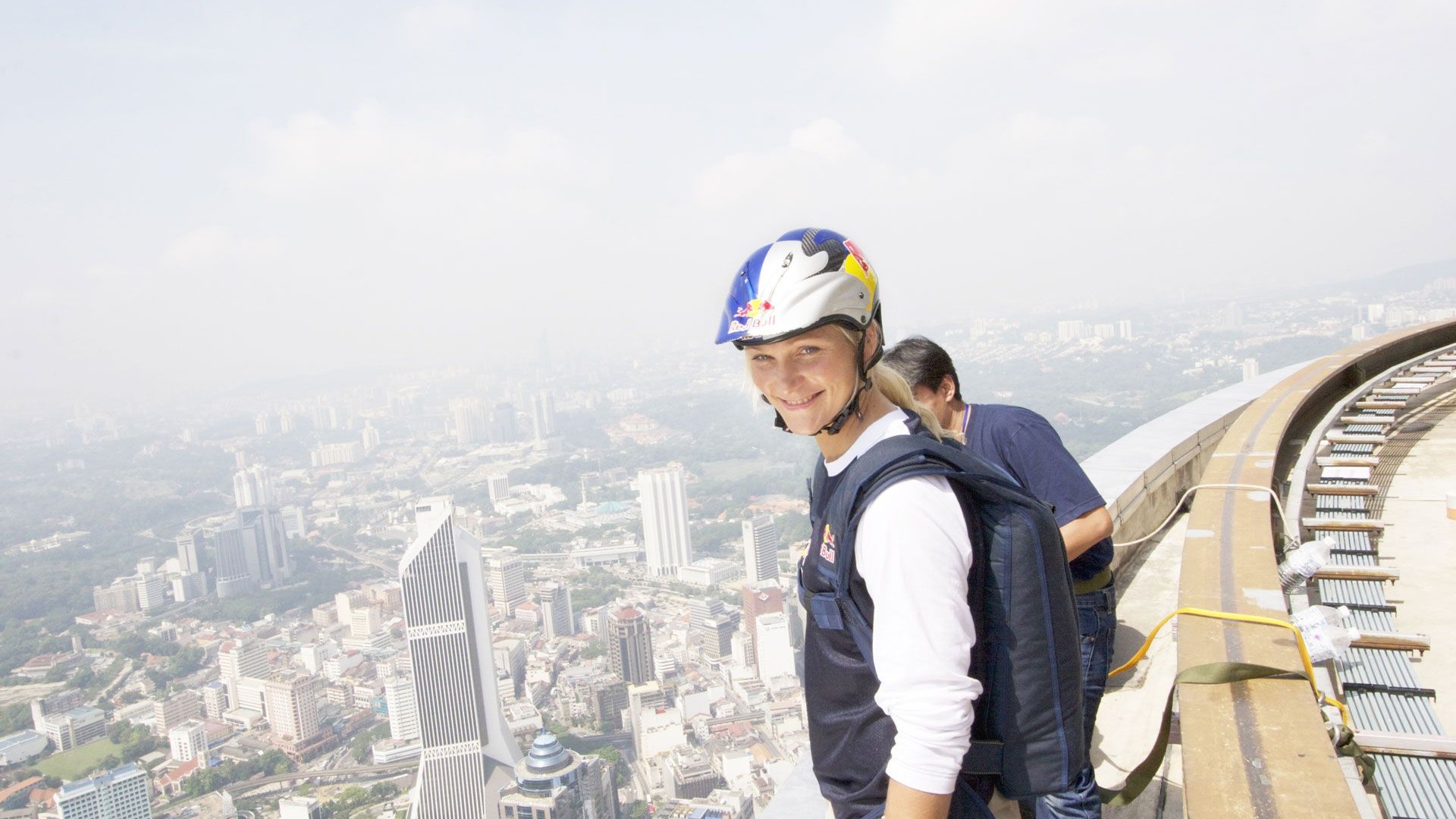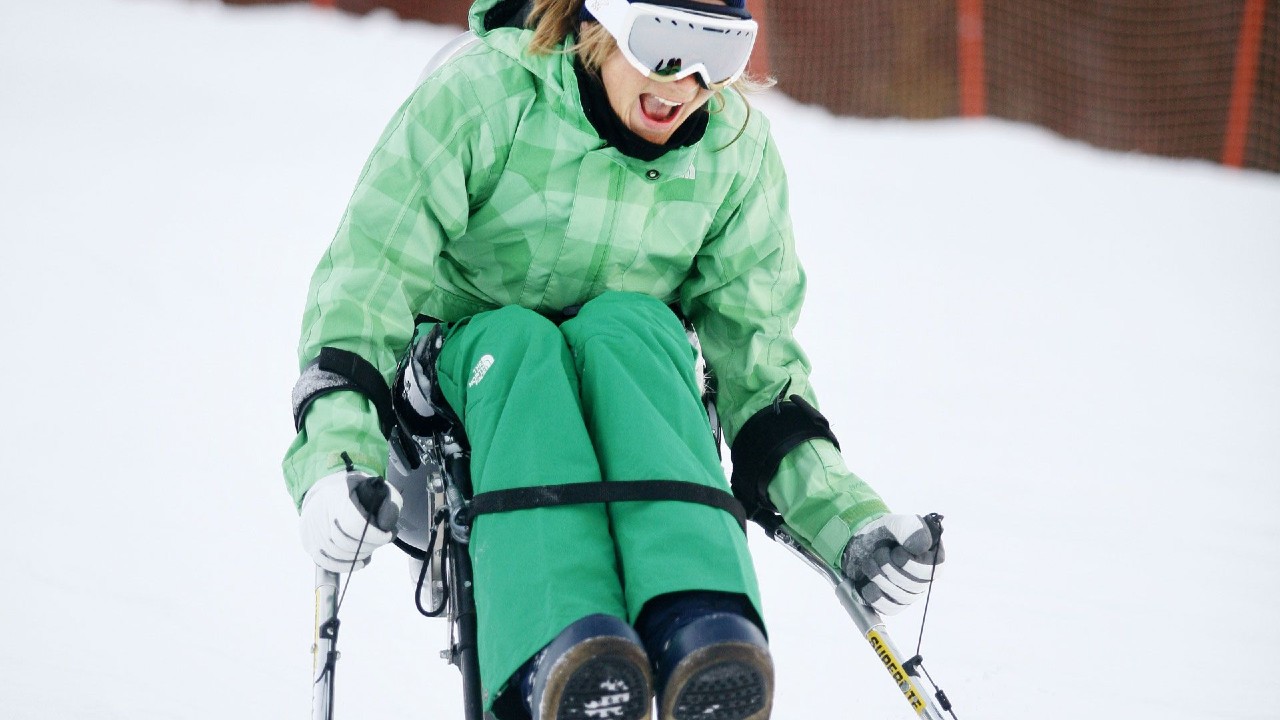Falling Toward Grace
Six years ago, a parachuting accident left extreme-sports daredevil Karina Hollekim near dead. Doctors said she'd never walk again, that her life as she knew it was over. But in the grueling years that followed, Hollekim had an epiphany: What if losing everything was the best thing that had ever happened to her?

She'd done this jump hundreds of times before. No big deal, really, not for someone like her. It was August 2006, and Karina Hollekim and a half-dozen friends had been invited to perform in the Paragliding World Cup in Villeneuve, Switzerland, on the placid shore of Lake Geneva. It was late morning when the group boarded a Cessna that, within 15 minutes, carried them aloft 10,000 feet. Everyone was happy, joking with one another. Hollekim, then 30, was looking forward to the jump, which was considerably less complicated than ones she'd been doing recently, including some that involved hurling herself off palpitation-inducing cliffs and soaring past jagged outcroppings. This time, all she had to do was leap from the plane in her white custom wingsuit with a camera attached to her helmet. A canister of smoke attached to her ankle would trace her movements as she soared across the sky so the audience below could follow her. It had rained that morning, but now rays of sun pierced the dark clouds. I'm living a dream life, Hollekim thought as the plane circled above the lush meadows and snowy Alpine peaks. I have everything I've ever wanted.
Once the pilot indicated they had reached the right location, one of the jumpers opened the door, filling the cabin with the loud rush of air. One by one, Hollekim's friends jumped. And then it was her turn. She approached the edge of the door, looked down, and leaped into the void, and just like that, she was gliding, the wind buoying her as she extended her arms and legs. Flying at 90 miles an hour, adrenaline coursing through her body, she flew so close to one of her friends that she could see the smile on her face. It felt like a perfect jump.
Because Hollekim was filming, she was the last to deploy her parachute. She reached into the pocket of the pack on her back and released the chute. Then she pulled the brake toggle, to control the speed and trajectory of her descent. But her chute had deployed at an angle, tangling the brake lines. The right half of the chute crumpled, and Hollekim began to spin like a helicopter blade, whipping around at 60 miles an hour. Flailing, she fought to regain control, trying to bank right, then left. Though the partially open chute slowed her fall, nothing could stop the spinning. She was too close to the ground to deploy the backup chute. The earth hurtled toward her. Over and over, the thought raced through her mind: I am going to die.

When Karina Hollekim was 4 years old, she was returning home to Oslo from a trip to the mountains with her parents when an oncoming car drifted into their lane. Her father swerved, but they were hit head-on. Her mother absorbed the brunt of the crash and was left brain-damaged and partially paralyzed. When she woke from a coma four months later, she didn't recognize her daughter. The accident obliterated what was left of Hollekim's parents' already-hobbled marriage and the pair divorced. After that, Hollekim moved in with her father, Bjorn Sonsterud. He'd always loved the outdoors and risky pursuits like rock climbing and paragliding and nurtured in his daughter the same passion. When she was still little, he'd tuck her away in his knapsack, holes cut out of the bottom for her legs to dangle, and climb with her on his back. "Just look up," he'd tell her when she was overcome by a fear of heights.
By the time Hollekim was a teenager, she was already an expert skier. But Sonsterud was a strict father, and his daughter bristled at the rigid upbringing. The older she got, the more she pushed back against her father's rules. She rarely obeyed his curfews, and when he punished her by forbidding her from going skiing with him over Christmas, she ignored him and went on her own. When she returned, she discovered a Post-it note on her backpack that read, "This is no longer your home." She was just 14.
Hollekim moved in with her uncle, also in Oslo, and resumed skiing. By age 16, she already had clothing and equipment sponsors; by 21, she was competing all over Europe. After a summer spent working as a computer programmer, she realized that she could never enjoy a career that confined her to a desk, so she quit to ski full-time. She excelled at it, to be sure, but her Nordic good looks — the blonde hair, tawny skin, and piercing blue eyes — also helped make her a sponsor favorite. Producers tapped her to star in extreme-sports videos that had her skiing down impossibly steep Alaskan peaks and catching air in the Wyoming backcountry. Though she'd reconciled with her father a few years after she moved out, nothing could tie her down. She all but abandoned Norway to join a global tribe of thrill-seeking athletes, rootless nomads who eschewed families and jobs and all the other trappings of a settled life in favor of adventure. "I felt at home with these people," she recalls.
In 2000, Hollekim met Jeb Corliss, who introduced her to BASE jumping — parachuting from a fixed position. (BASE is an acronym for buildings, antennae, spans, and earth formations, like cliffs — the four fixed objects a BASE jumper leaps from.) Corliss was among the best in the world at this fringe sport. Hollekim had already been skydiving and liked it well enough, but BASE jumping was another thing entirely — the focus it required and the rush it delivered made it addictive. Corliss took her to Twin Falls, Idaho, home to a growing community of jumpers who used the Perrine Bridge, some 486 feet above the Snake River, for their practice jumps. "Every time I went near a big cliff, I had a sensation like I wanted to let myself go, like something was sucking me over the edge," she recalls. "I had to fill that empty space with something. So I filled it with BASE jumping."
Get exclusive access to fashion and beauty trends, hot-off-the-press celebrity news, and more.
Not long after, she met JT Holmes, the ruggedly handsome champion American skier and ski BASE jumper from Squaw Valley, California. They dated briefly, and during that time he taught Hollekim how to BASE jump from cliffs hundreds of feet high — while on skis. The risks were staggering. Powerful gusts of wind can easily push a skier back into the cliff face or flip her upside down, making it impossible to safely deploy a parachute. But the challenge only seemed to whet Hollekim's appetite, and soon she became the first woman to ever ski BASE. In the ultracompetitive, ultra-macho world of BASE jumpers, Hollekim held her own. She and a friend were the first to do a wingsuit jump off Kaga Tondo, a vertiginous 2,000-foot-tall sandstone spire in the Mali desert. She leaped off Shanghai's 88-story Jin Mao Tower in celebration of China's National Day. For 300 days of the year, she was either skiing and jumping competitively or being filmed for extreme-sports videos. She enjoyed a reputation for always pushing the envelope.

Hollekim doesn't remember actually hitting the ground, only coming to. She opened her eyes to see her legs twisted and splayed, bent up alongside her torso like they were someone else's. Is this what it feels like to be dead? Jagged pieces of bone had pierced through her shredded skin. The lower half of her body looked like it had been worked over with a sledgehammer. Just then, excruciating pain surged through her body. If I'm in pain, I must be alive. Dazed and anguished, she blacked out.
Airlifted to nearby Lausanne Hospital, Hollekim awoke two days later alone in a hospital room, disoriented and in agony. A stone-faced doctor delivered the news: Her right leg had suffered 21 open fractures, while the left leg had been shattered into four pieces. "You'll never walk again," he told her grimly. Hollekim was stunned and could summon no words. "It was unreal, incomprehensible," she recalls. "I used my body for everything. All of it was taken from me. I just lay there for hours by myself, crying."
Hollekim's father received the call about his daughter from one of her companions that day and caught the first flight he could to Switzerland. He knew his daughter was alive, but not much else, and didn't know what to expect. He was used to seeing her in the hospital — she'd been in and out of emergency rooms with ski injuries. But this, he knew, was different. Like many of her friends, he had been worried about her BASE jumping, that it would be just a matter of time before tragedy struck, and now the time had finally come. When he opened the door to her hospital room, his vivacious, beautiful daughter was barely recognizable. Her right leg was in an external fixation — a metal cage with pins running into the skin. She had tubes jutting out from her arms. Her face was pallid and gray from all the blood she'd lost. Remembers Sonsterud, "It was hard to see her. She was totally wasted."
Those first few nights, he stayed beside her, pushing the button that released morphine into her IV drip so she wouldn't wake from the pain. During the day, he did his best to hide his own fears, devising ways to keep her spirits up and his mind off the challenges to come. In the ensuing weeks, her friends trickled in for visits. Privately, Hollekim confided in her father that she was terrified of withering away in a wheelchair for the rest of her days. Sonsterud shared her fears but wouldn't allow either of them to entertain them, commanding her to focus on each day and only each day. "You have to eat the elephant step by step. If you look too far ahead, everything seems impossible," he told her. Hollekim was surprised at her father. She'd never thought of him as optimistic. "He's not wired like that at all," she says. But deep down he knew that she needed to think positively to survive what lay ahead.
Over the next four months, Hollekim underwent 14 surgeries on her legs. (Remarkably, she had suffered injuries nowhere else.) A rod had to be inserted in her left leg. On the right leg, surgeons removed 4 inches of femur, then harvested bone from both her hips and lower back to graft onto the pulverized leg bone. They severed her femur near the hip and rotated the leg 45 degrees. The bone was then attached to plates that were bolted at the knee and hip. Her thigh was cut open so that the layers of muscle that had fused together from months of inactivity could be separated. Long incisions in her leg were kept open for days at a time as her medical team went in and out for more surgeries. She was plagued by infections, one so bad it caused her wound to burst. Frustrated, her doctors were on the verge of amputating when one last surgery revealed a wad of grass and gravel buried deep in her leg. Once it was removed, the infections ceased.
By the time Hollekim was released from the hospital in December 2006, the 6-foot-tall dynamo was a gaunt 100 pounds. She and her father returned to Oslo, where she was admitted to an inpatient rehabilitation facility. Almost immobile and surrounded by paraplegics, quadriplegics, and amputees, Hollekim came face-to-face with her future. "It was a shock," she says, growing softer as she recounts the scene. "I realized that I was one of them. I'd never walk again. This was my life now."
Hollekim sank into depression. Her father knew that she was crying herself to sleep every night. He stayed close, visiting every day for the first few weeks. He tried pushing her, telling her that her job was simply to get stronger each day. But she grew increasingly despondent. Finally, when one of her physical therapists gave her a pair of boxing gloves and told her to start punching, it was as if a faucet had been opened and all of her fury poured into those gloves. Hollekim hit the therapist hard. Wild and unleashed, she hit him again. "I screamed out all of my frustration and sadness and depression," she says. She was so exhausted afterward that she was sick for two days. But Hollekim had finally found a way to use her body — and that gave her hope.
After that, Hollekim threw herself into rehab. The process was tortuously slow and exceedingly painful. It took a year for her to attempt her first steps. Wearing boxer shorts that hung off her skeletal frame, she grabbed hold of a chest-high walker, transferred her weight onto it, and inched across her room and down the hall on legs so atrophied that her knees bulged wider than her thighs. Her doctors stared in disbelief. One nurse started weeping.

Before the accident, if you had asked me what I would do if I ever wound up in a wheelchair, I would have said, 'Shoot me.' Everything I did, everything I loved, was physical, and if that was ever taken from me, I would not want to live anymore," Hollekim says.
But that's not at all what happened. Even in her darkest moments, Hollekim never grew bitter, never withdrew from the world or lost herself brooding over why this had happened to her. She didn't relive that morning in her head, and never experienced the hypervigilance or emotional numbness symptomatic of post-traumatic stress disorder (PTSD), common to those who've survived a life-shattering experience.
Quite the contrary: In the months and years that followed her accident, Hollekim seemed to blossom in that rehabilitation facility, and beyond. Sure, she had a lot to figure out. Who was she without skiing and jumping? She had to reimagine herself, and that terrified her. But navigating those uncertainties opened up a world of possibilities she'd never considered before. Her father, for example, once a source of turmoil in her life, had now become a source of solace and unflagging support.
There was an unexpected flicker of promise elsewhere, too. The night before her accident, Hollekim had met Hernan Pitocco, an Argentine paraglider. They had flirted and kissed, and she planned to go out with him after her jump. He visited her in the hospital a few times that first month and called regularly. "Imagine, falling in love in the middle of this tragedy," she says. Over the next year, they resumed their fledgling romance. And while it didn't work out, the relationship nonetheless proved seminal. "I couldn't understand how he could become my boyfriend. I felt like there was nothing left of me," she says. "But he told me that I was still the same girl that he fell in love with, that she is going to come back."
And in that facility, as she rallied the will and strength to pull her legs forward, it occurred to Hollekim that, despite her injuries and the enormous setbacks she was facing, she could still be happy. "This wasn't the worst-case scenario. Realizing that I was much more than a functional body, that was a very good moment."
The realization and the dramatic changes that followed are hallmarks of a remarkably common psychological change called post-traumatic growth. The term was coined in the early '90s by psychologists Richard Tedeschi and Lawrence Calhoun, a pair of clinicians and researchers at the University of North Carolina, Charlotte, who began by surveying hundreds of people who had survived severe injuries or lost a spouse. Over and over again, the researchers heard how those terrible events had sparked changes in the victims, who reported experiencing feelings like a renewed appreciation for life, new possibilities for themselves, enhanced personal strength, improved relationships, and spiritual change. Understanding why some people experience this kind of growth has become something of a hot field in psychology. (The U.S. Army, for example, is currently conducting a large study of post-traumatic growth in combat veterans.)

The kind of personal growth Hollekim experienced requires what researchers call a "seismic event" so devastating that it compels a re-evaluation of one's core beliefs. And, in doing so, the survivor reconstructs his or her sense of self, becoming a better, wiser person in the process. You hear human-interest stories like it all the time on TV (the battle-scarred soldier who decides to devote his life to helping others, for example) and in pop culture (if he had never witnessed the death of his parents, Bruce Wayne would never have become the defender of Gotham). Growth is the archetypal hero's journey. There's still pain and suffering, of course — studies show that those with the worst cases of PTSD report the most growth — but it usually results in a hard-won sense of wisdom, a fuller life lived with more meaning.
Hollekim's fall inspired an honest, occasionally brutal assessment of how self-centered she had been before the accident. She rarely considered how the risky sports she pursued affected those around her, how her adrenaline-junkie fixes made it hard for her to forge real relationships. Now, Hollekim says, she is a more attentive and responsible friend and daughter. A successful motivational speaker, she relishes engaging with those who connect with her story. It gives her harrowing accident and grueling recovery a purpose. "I have grown a lot. I am wiser in my decisions and appreciate what I have," she says. "I am thankful it happened."
Three years after her accident, Hollekim was walking but still in constant pain. She had trouble getting into and out of a car. The climb to her fifth-floor walk-up apartment was excruciating. She had been on painkillers for so long that she had to go through detox twice. Finally, she entered the Red Bull Diagnostic and Training Center, a cutting-edge facility for athletes recovering from injury, just outside Salzburg, Austria. For the next year, she relearned the mechanics of walking. Everything she did there hurt, yet her doctors were amazed by her perseverance. Under their watch, her muscles began to heal and function properly. And over time, the pain began to dissipate and the limping all but disappeared. Finally, she was able to set her sights on her real dream: to get back on skis. She could not have picked a more perilous goal — her legs are held together by so many plates and screws that an X-ray of them might resemble the bargain bin at a hardware store. A simple fall could have put her back in the hospital. But there was no dissuading her.
In January of 2010, Hollekim visited Hemsedal, a large ski resort in Norway, accompanied by friends and family. The mountain opened an hour early just for her. It was dark, two hours before dawn, and the trails glowed under artificial light. Hollekim was seated on the ski lift with her father and a camera crew documenting her run. A gaggle of friends gathered at the base of the hill, including Hollekim's mother, who herself had endured years of rehab so she could walk again. Hollekim, terrified that her legs would fail her, took a deep breath as she eased off the lift. Then she dug her poles in and forged ahead.